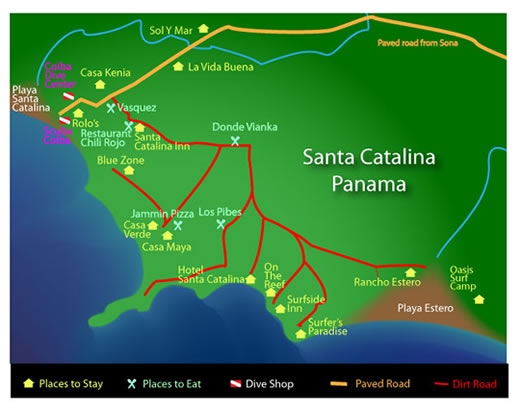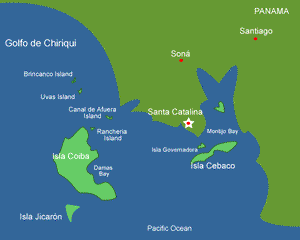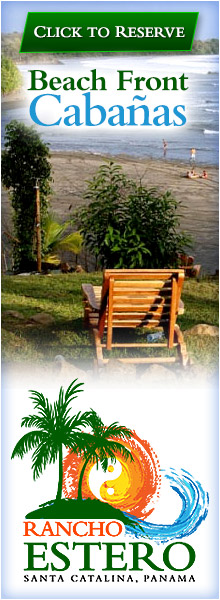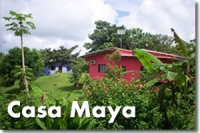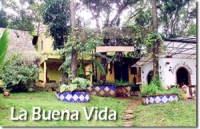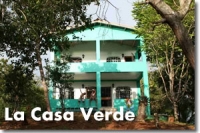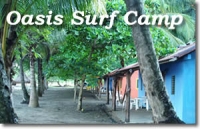Things to see and do in and around Santa Catalina, Panama
The attraction to Santa Catalina, Panama is its natural beauty and vast natural resources. With the Pacific Ocean roaring up on its beautiful black sand beaches, Santa Catalina is the launching point for fantastic nautical adventures and a serene fishing village.
Surfing has for decades been the main draw for visitors to Santa Catalina. But the reason Santa Catalina exists is its access to abundant fish populations. Fishing and scuba diving are rapidly growing in popularity.
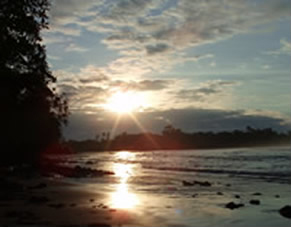 The same type volcanic outcroppings that create the incredible surf break at Playa Santa Catalina, create excellent dive and fishing spots just offshore. A short boat ride from shore delivers the diving and angling enthusiast enormous populations of fish and underwater structure.
The same type volcanic outcroppings that create the incredible surf break at Playa Santa Catalina, create excellent dive and fishing spots just offshore. A short boat ride from shore delivers the diving and angling enthusiast enormous populations of fish and underwater structure.
Dozens of islands are scattered through out the ocean, just a short boat ride from Santa Catalina. Many of these islands offer relatively unexplored white sand beaches with surf breaks that equal and sometimes better the world renowned break at La Punta in Santa Catalina.
On land, Santa Catalina offers beautiful beaches, good food and affordable accommodations. Visitors to Santa Catalina come for outdoor recreation and relaxation. While there are a number of gathering spots for evening dinners and socializing, Santa Catalina is not the all night party spot found in a lot of Central American surf destinations. The person wandering the beach at 5 am is more likely an early bird surfer grabbing some solo time with the waves than a straggler partier left over from the night before.
With its flocks of parrots, warm waters and uncrowded beaches, Santa Catalina, Panama offers travelers the option for a quiet getaway or an activity filled vacation. Whether your ideal day is lounging undisturbed on an isolated beach or a day of scuba, surfing and playing soccer on the beach, Santa Catalina can fill your dreams.
Beaches
The two primary beaches in Santa Catalina are Playa Santa Catalina and Playa Estero. Both are black sand beaches produced from an adjacent river and offer gentle waves with large tide changes through out the day. While Playa Santa Catalina is the busier of the two, either can offer a pick up soccer game or other activities with the locals.
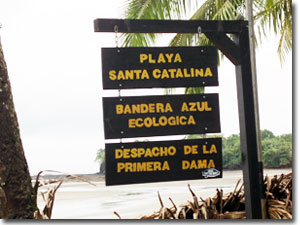 The beach waters around Santa Catalina are routinely tested are have been awarded the Bandera Azul Ecologica or Ecologic Blue Banner award for their purity.
The beach waters around Santa Catalina are routinely tested are have been awarded the Bandera Azul Ecologica or Ecologic Blue Banner award for their purity.
Playa Santa Catalina
Playa Santa Catalina is the main village beach located at the end of the paved road. This is the hub of activity for the fishing village of Santa Catalina. Most of the daily scuba diving trips and fishing boats leave from Playa Santa Catalina. Directly in front of the beach is a view of Isla Santa Catalina. The adjacent river gives overnight harbor to the local fishing pangas.
Playa Estero
Playa Estero is east of town across the small river at the end of the dirt road which starts at the intersection in town by the phone booth and the Vasquez store. Playa Estero generally has less activity through out the day and is often completely empty. It offers a nice steady set of waves for body surfing or beginners to learn to surf. Except during very heavy rains, the river is only calf deep and can be easily crossed.
Getting to Santa Catalina, Panama
Santa Catalina is about an hour and a half drive South Southwest from Santiago. Whether you are coming from Panama City or David, you will travel through Santiago. If you are driving from Panama City to Santa Catalina, plan on a 5 to 6 hour trip, but allow 7 to 8 hours in case of construction, rain, or side trips. Plan to arrive while it is still light because the roads are used as sidewalks by the locals and livestock is frequently loose and roaming the roads. This is particularly true of the secondary roads between Santiago and Santa Catalina.
From Panama City to Santiago:
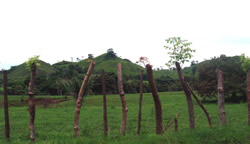 The 3 1/2 to 4 hour trip from Panama City to Santiago is a pretty straight forward drive down Highway 1, know as the Pan American Highway. The speed limit is 100 km/hr along the rural parts of the highway, but drop frequently to 60 km/hr or less. This highway is heavily patrolled and keeping aware of the limit change is a very good idea.
The 3 1/2 to 4 hour trip from Panama City to Santiago is a pretty straight forward drive down Highway 1, know as the Pan American Highway. The speed limit is 100 km/hr along the rural parts of the highway, but drop frequently to 60 km/hr or less. This highway is heavily patrolled and keeping aware of the limit change is a very good idea.
The most difficult part of the trip is finding the turn for Soná. It involves several turns through town. The first turn is to the left about half way through town on Avenidad Central. It angles at about a 45 degree angle and is not well marked.
Avenidad Central will take you through the main shopping area and run directly into the Cathedral. At the Cathedral, turn right and immediately back to the left, following the side of the Cathedral. In one block (at the back of the Cathedral) turn right. Continue for 2 blocks and turn left where a small sign points to Soná.
Santiago to Soná:
The road to Soná is 2 lane and rougher than the Pan American Highway, but generally in good condition. Typically, it will take 30 to 45 minutes. As with any secondary road in Panama, watch for pedestrians, bicycles, livestock, wildlife and the unknown! It is a picturesque drive with rolling hills and farms.
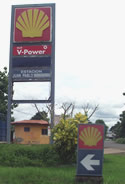 Shortly before entering Soná there is an intersection with a Shell gas station on the corner and a large number of signs. Guide books tell you it is a well marked turn, but the sign may have damage. The gas station is a better landmark.
Shortly before entering Soná there is an intersection with a Shell gas station on the corner and a large number of signs. Guide books tell you it is a well marked turn, but the sign may have damage. The gas station is a better landmark.
A left turn here puts you on the road to Santa Catalina. If you need cash, bottled 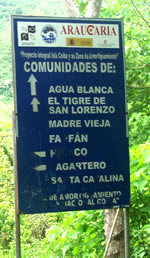 water, gas, food, or supplies. You should stop here or drive the short drive into Soná. There are few to no options in Santa Catalina for these items.
water, gas, food, or supplies. You should stop here or drive the short drive into Soná. There are few to no options in Santa Catalina for these items.
Soná to Santa Catalina:
This part of the trip offers views of a number of local villages where the residents live in thatch huts, ride horses, and work on the large “fincas” or agricultural units in the area. While the road is in good condition and the winding nature of it tempts the race car driver in you, caution is the rule of the road. Anywhere along the way, the road could be lined with chickens, people, cattle, horses, or wildlife. It is a pretty drive. Drive slow enough to enjoy it!
The recently paved road to Santa Catalina makes 4 wheel drive no longer a necessity. About half way to Santa Catalina, you will make a left turn at a well marked intersection. Straight would take you to Los Tigres. Plan on the Soná to Santa Catalina portion of the trip to take at least an hour.
Scuba Diving in the Santa Catalina Area
Scuba divers visiting Santa Catalina have two major options; Local diving within 15 minutes of Playa Santa Catalina or trips to the Coiba National Park. Both are spectacular diving, offering excellent examples of Panama's Pacific Ocean riches.
Santa Catalina Local Scuba Dives
Local trips can offer as great a variety and quantity of fish as virtually any dive site in the world. During the rainy season, visibility can be affected by run off from area rivers. Of course it is this nutrient rich run off which holds millions of fish in the near shore reefs around Santa Catalina. When this happens, it is a simple matter to switch the dive plan to include dives in the Isla Coiba National Park.
It is common for Santa Catalina scuba divers on local dives to see large schools containing hundreds of different tropical fish, crevalle jacks, barracuda, and various types of snappers. Scattered through out the reefs, are good quantities of eels, grouper, lobsters, crabs and other common reef dwellers. Visits from turtles, white tip reef sharks and nurse sharks are frequent. Depending on the dive site, the bottoms ranges from craggy volcanic rock full of rock dwellers to beautiful assortments of corals.
Experiencing a local scuba dive in Santa Catalina is highly recommended as it offers a very affordable dive that is very convenient, often returning by noon to enjoy the gentle waves of Playa El Estero or Playa Santa Catalina in the afternoon.
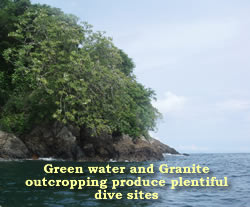 Isla Coiba Scuba Dives
Isla Coiba Scuba Dives
Santa Catalina is currently the best mainland base from which to launch day scuba dive trips to Isla Coiba. With an hour to an hour and a half boat trip to Isla Coiba from the beach at Santa Catalina, time to access to the national park is cut by at least half compared to most other launching points along the Panamanian Pacific coast.
Because of the cost of park admission and extra gas and time for the boat and crew, day trips to Isla Coiba run roughly 60% to 70% more than local Santa Catalina dives. For the extra money, you are offered world class diving that has been favorably compared as a combination of the Galapagos and Cocos Islands.
In addition to the great variety and quantity of fish and coral offered in the local dives, Isla Coiba offers opportunities for viewing large quantities of pelagic, such tuna, various rays, sailfish, marlin, whales, dolphin and sharks. Surface intervals are opportunities to explore the unique wildlife and unspoiled beaches of Coiba and surrounding islands.
Another option offered from Santa Catalina is two to three day combination scuba dive and eco-tour trips to Isla Coiba. Overnights will be at the ANAM ranger station. Access to this area is very limited and arranged by reservation by your dive guide. This option provides multiple world class dives with eco-tours through one of the world’s finest virgin rainforest and all the unique plants and animals it has to offer. Still relatively unexplored and unknown even to the scientific community, Isla Coiba offers an unspoiled and uncrowded adventure available from few other places in the world.
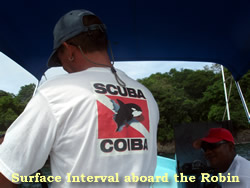 Dive Facilities
Dive Facilities
There are two land based scuba centers in Santa Catalina:
- Scuba Coiba has the longest history in Santa Catalina and is owned and operated by Austrian native Herbie Sunk.
- The similarly named Coiba Dive Center is owned by Canadian Glenn Massingham. Glenn has extensive experience diving the areas around Coiba and Santa Catalina.
Scuba Coiba offers dives from their 25 ft dive boat “Robin.” Robin can comfortably dive up to six people. The Coiba Dive Center uses similar locally owned boats called pangas. Because these are the only dive operations based out of Santa Catalina, dives are not crowded and the dive sites are virtually unexplored, often offering the opportunity to be some of the first divers to ever see a site!
Both dive operations are very professional and safety conscience. The equipment is in good shape and they take care to make your dive enjoyable. They are located almost across the street from each other at the end of the paved road just before the beach at Santa Catalina.
Surfing Santa Catalina, Panama
Surfing in Santa Catalina, Panama is world class. Kept secret for years by Panama's surfing elite, word has gotten out about Santa Catalina's consistent and powerful break. Santa Catalina offers the most consistent, easy to line up, big wave in Central America if not all of the Americas. Even still, because of it's remote location and the number of options, surfing is relatively uncrowded much of the time.
A number of surf camps have sprung up, offering a range of overnight options. Surfers can stay in air conditioned rooms with private baths around $30 to $40 per night or camp near the break at $5 per night with a variety of options in between. Some of the camps offer a meal package for an extra $10 to $15 dollars a day for 3 meals.
Most of the surf is for experienced surfers with the exception of Estero, where beginners can practice on smaller, yet consistent waves and a sand beach.. Lessons and board rental are available from a local surf camp.
For experienced surfers, Santa Catalina, Panama offers powerful hollows that break both left and right. The bottom is rocky and the volcanic rock can be tough on feet, heads and boards! The waves roll in year round and typically range 4 to 15 feet, with the largest between February and August when faces can push 20 to 25 feet.
The water is warm year round. Wetsuits are not needed. Bring plenty of sunscreen, warm water wax and a pair of reef shoes to protect against the volcanic rocks.
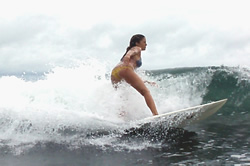 Santa Catalina Surf Spots - In or Near Santa Catalina
Santa Catalina Surf Spots - In or Near Santa Catalina
The area around Santa Catalina offers some of the greatest variety and consistency of surf conditions in the world and is the prime surf destination of Panama and Central America. Here are a few of the options:
- Santa Catalina - The reason surfers started coming to the area! Left and right breaks, tall and powerful waves. Best at high and medium tide. Low tide should be left for very experienced surfers with a lot of local knowledge. Very consistent break 80% of the time with the other 20% being knee to head high.
- Punta Brava - about a half hour walk to the southeast. Is actually 3 breaks, 2 lefts and 1 right. The main break is to the left over a rock bottom. Tends to be bigger and more consistent than the main break at Santa Catalina. Sometimes, the waves are much larger than Santa Catalina's.
- Punta Roca - about a 45 minute walk to the northeast or 10 minutes by boat, the break is a hollow left over a rock bottom with waves similar in size to Santa Catalina.
- San Pedrillo - Beautiful beach break with powerful lefts and rights, 20 minutes boat ride from Santa Catalina.
- Cimarron - located off a tiny island, Cimarron offers a left break in a beautiful and isolated area. From an anchored boat just of the island, the break is a short paddle of no more than a hundred feet.
- El Estero - located next to town, offers a nice sand beach and smaller waves breaking both left and right.
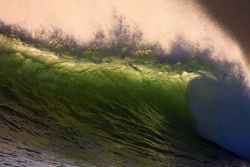 Other Surf Breaks off Isla Cebaco and Isla Coiba remain local secrets and are best visited by hiring a local operator such as the boats at Punta Brava Lodge. The boat ride to these pristine sites could be between 45 minutes to 4 hours depending on the site and the speed of the boat. For instance, the south shore of Isla Coiba in a boat with a large outboard engine could takes an hour and a half or up to 3 hours in some of the smaller local pangas.
Other Surf Breaks off Isla Cebaco and Isla Coiba remain local secrets and are best visited by hiring a local operator such as the boats at Punta Brava Lodge. The boat ride to these pristine sites could be between 45 minutes to 4 hours depending on the site and the speed of the boat. For instance, the south shore of Isla Coiba in a boat with a large outboard engine could takes an hour and a half or up to 3 hours in some of the smaller local pangas.- La Puntica - the little point
Islands around Santa Catalina
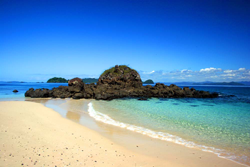 The islands around Santa Catalina offer incredible opportunities for exploration, and virgin surf sites with awesome breaks. Local boats called pangas can be hired to explore these islands or arrangements can be made through the surf camps.
The islands around Santa Catalina offer incredible opportunities for exploration, and virgin surf sites with awesome breaks. Local boats called pangas can be hired to explore these islands or arrangements can be made through the surf camps.
- Cebaco - a boat ride to Isla Cebaco can offer larger waves with fewer riders. It offers beach and point breaks and left and right breaking waves.
- Montuosa
- Jicaron
- Cativo
- Octavia
- Pelonas
- Isla Coiba and Coiba National Park - a great side trip for its incredible variety of plants, animals and birds. The scuba diving here is world class with large pelagics, massive schools of fish, and untouched beauty.
